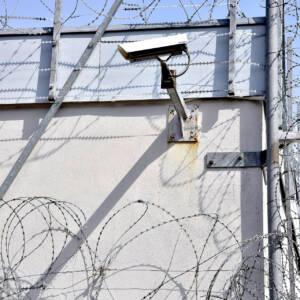Customer Stories
LOCATION: U.S. Correctional Facilities
On The Inside And Out: How Video Surveillance Is Essential To Prison Security
For most people, prison ranks high on the list of places to avoid. Yet, take no pride: U.S. prisons are filled to capacity with individuals who have committed some type of crime that warrants incarceration.
In 2018, according to data from the Prison Policy Initiative, there were 1.3 million U.S. adults in prison and 615,000 incarcerated in jails for crimes ranging from murder, manslaughter, illegal drug possession, burglary, theft, driving under the influence, property crimes, and more.

On The Inside And Out: How Video Surveillance Is Essential To Prison Security
For most people, prison ranks high on the list of places to avoid. Yet, take no pride: U.S. prisons are filled to capacity with individuals who have committed some type of crime that warrants incarceration.
In 2018, according to data from the Prison Policy Initiative, there were 1.3 million U.S. adults in prison and 615,000 incarcerated in jails for crimes ranging from murder, manslaughter, illegal drug possession, burglary, theft, driving under the influence, property crimes, and more.

In addition to traditional security concerns such as perimeter surveillance, ID card management, visitor and vendor management, crime, and theft, prisons, and correctional facilities have unique security challenges that other enterprises typically do not have. Those include inmate escapes, hostage situations, gangs, contraband, riots, and overcrowding, in addition to increasing privacy and regulatory mandates.
Even more, correctional facilities face regular security audits that are conducted by the National Institute of Corrections. Security teams must always be on guard and watching every individual and action of the inmate population – for an inmate’s physical safety – in addition to their own.
It is not uncommon for security staff and correctional officers to receive physical injuries from prisoners, especially when trying to break up an inmate fight or transporting them to other locations.
An emerging concern for prison officials is drones by individuals who are looking to smuggle drugs, cellphones, weapons, and other contraband into prisons for use by inmates. Many states are working on anti-drone legislation around correctional institutions.
For example, Missouri is one of the most recent U.S. states that has introduced legislation to tackle the problem. Missouri HB 324 would make it illegal for drone pilots to fly an unmanned aircraft near any correctional center, private jail, county jail, municipal jail, or mental health hospital. Anyone caught violating the law would be charged with a Class A misdemeanor and possibly other felony charges, depending on the pilot’s illegal intentions.





Video Surveillance’s Role
Video surveillance is a necessary security technology for prison and correctional facility staff, as it allows personnel to mitigate those unique security challenges.
Video surveillance is prevalent throughout facilities; even if it’s a typical two-bed jail cell or a 2,000 bed prison,” says Brad Wareham, Director of Key Accounts at Salient Systems. “In cases where facilities face a shortage of staff members to watch over the inmate population, video surveillance supports the oversight of inmates and increases accountability.
Inmates know that despite the lack of staff and officer presence, they are being observed by cameras that can catch even the smallest details. Video surveillance can follow inmates anywhere. There are very few blind spots,” he says. Increasingly, prisons and correctional facilities are upgrading their older analog video systems, due to age degradation and lack of adequate support resources.
“They are upgrading to hybrid and/or fully digital solutions, all while maintaining the Human Machine Interfaces (HMI) model,” Wareham notes.
They continue to face security challenges typical of the corrections space, such as PLC controllers, RTSP capture, intercoms, lock controls, and more, which are atypical of larger facilities. In addition, many older analog solutions will eventually be cost prohibitive, Wareham says, and will no longer operate, due to an increasing inability to find replacement parts and to the proliferation of IP-based video surveillance solutions.
For many correctional facilities, upgrading a video surveillance system to an IP-based solution, in addition to a video management system (VMS), makes sense and benefits a prison or correctional facility in multiple ways.
Solutions exist that allow prison facilities to keep pre-existing hardware in place during an upgrade, while allowing for replacements and component upgrades as funding permits.
Specific benefits that advanced video surveillance and VMS solutions can provide a
correctional institution include:
Increased Coverage – Many prisons and correctional facilities are large, and have multiple areas that need to be under surveillance, such as hallways, throughout cellblocks, healthcare facilities, dining areas, exercise yards, and more. Outdated systems may have a difficult time monitoring all areas, while an IP video system can provide continuous coverage of an entire facility.
Clarity of Video – Older analog cameras struggle with the ability to provide clear images. New IP cameras, coupled with an advanced VMS, will produce crisp and clear images that are necessary to mitigate security risks.
Inmate Tracking – One of the biggest benefit of a VMS solutions is video analytic software, which is capable of tracking a moving target and searching for specific objects. Video analytics can count human beings, monitor queues, and even identify a geographical location. VMS solutions allow security to search video archives quickly and find archived video that matches custom criteria within minutes, which is helpful in investigations.
Alerts – Video analytics within a VMS solution can be programmed to detect specific activity and activate an alarm or alert system when the activity occurs.
Facial Recognition – The ability to recognize a face is another key benefit of a VMS solution used in a crowded correctional institution, in particular when inmates may be wearing the same type and color of clothing.
Perimeters – Video surveillance placement on the exterior perimeter of a facility can document suspicious activity occurring in outside recreational yards where contraband can enter. Many VMS solutions allow for detecting movement throughout specific areas for an established duration of time.
Mobility – The ability for correctional officers to view video on a mobile device is critical, given the large landscape of facilities.
For example, Salient’s TouchView Mobile solution, combined with its CompleteView 20/20 VMS, allows users to instantly access, monitor and review live and recorded video from any camera connected to any CompleteView 20/20 recording server. Cameras from multiple servers can be accessed simultaneously with PTZ control. The solution’s DRS (dynamic resolution scaling) automatically sizes the video for live viewing, which significantly reduces network usage and provides higher frame rates over mobile connections.
Overall, Wareham notes, video surveillance and VMS solutions are a necessary and critical solution for securing prisons and correctional facilities.
“You can’t have a correctional facility without video surveillance and an audit trail for forensic evidence,” he says. “Facilities with challenging budget constraints are still required to have a functional Video Management System, regardless of the technology or age of their infrastructure.”
For security integrators, Salient’s VMS solutions provide a steady ROI. “Salient plays a critical role in providing a viable cost per channel ROI that is superior in the VMS industry,” Wareham says. “As the requirements for third-party encoding hardware is negated, and coupled with our customer support for virtually all aspects of the detention and corrections space, Salient’s VMS solution addresses budget constraints.”
For prisons and correctional facilities, an advanced video surveillance and VMS is not just a product; it is a necessity that enables correctional facilities to stay safe and secure. “In the corrections industry, surveillance goes hand in hand with the employee, inmate, and visitor safety, while coupled with procedural compliance and enforcement,” Wareham says.
